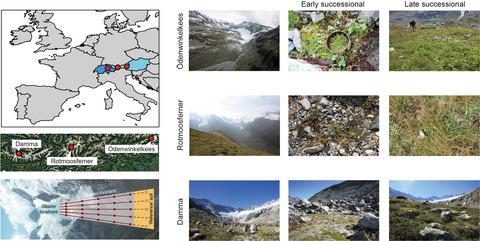Our official English website, www.x-mol.net, welcomes your
feedback! (Note: you will need to create a separate account there.)
Glacier forelands reveal fundamental plant and microbial controls on short-term ecosystem nitrogen retention
Journal of Ecology ( IF 5.3 ) Pub Date : 2021-07-15 , DOI: 10.1111/1365-2745.13748 Franciska T. de Vries 1, 2 , Cécile Thion 3, 4 , Michael Bahn 5 , Benoît Bergk Pinto 4 , Sébastien Cécillon 4 , Beat Frey 6 , Helen Grant 7 , Graeme W. Nicol 4 , Wolfgang Wanek 8 , James I. Prosser 3 , Richard D. Bardgett 2
中文翻译:

冰川前地揭示了对短期生态系统氮保留的基本植物和微生物控制
更新日期:2021-07-15
Journal of Ecology ( IF 5.3 ) Pub Date : 2021-07-15 , DOI: 10.1111/1365-2745.13748 Franciska T. de Vries 1, 2 , Cécile Thion 3, 4 , Michael Bahn 5 , Benoît Bergk Pinto 4 , Sébastien Cécillon 4 , Beat Frey 6 , Helen Grant 7 , Graeme W. Nicol 4 , Wolfgang Wanek 8 , James I. Prosser 3 , Richard D. Bardgett 2
Affiliation

|
- Human activities have massively increased the amount of reactive nitrogen in the biosphere, which is leading to increased nitrogen (N) inputs in terrestrial ecosystems. The retention of N is a crucial ecosystem function of both managed and natural ecosystems, and there is a long history of experimental, observational, and conceptual studies identifying its major controls. Yet, the plant and soil microbial controls on the retention of added N remain elusive.
- Here, we used three ecosystem chronosequences in front of retreating glaciers in the European Alps to test our hypothesis that the retention of added reactive 15N increases as succession proceeds, and to identify the plant and microbial controls on ecosystem N retention.
- We found that the uptake and retention of N did not change during succession, despite consistent changes in plant, soil, and microbial properties with increasing time since deglaciation. Instead, we found that plant and microbial properties that remained constant during succession controlled 15N uptake and retention: low root and microbial C/N ratios, as well as high root biomass, increased plant and microbial uptake of added N. In addition, high soil concentrations of nitrate and ammonium reduced the uptake of N in microbes and roots, respectively.
- Synthesis. Our results demonstrate that plant and microbial N demand, as well as soil N availability, drive the short-term retention of added N during succession in glacier forelands. This finding represents an advance in our understanding of the fundamental controls on ecosystem N retention and the role of plant-microbial interactions in this process. Such understanding is crucial for predicting and mitigating the response of terrestrial ecosystems to the ever-increasing amounts of reactive N in the biosphere.
中文翻译:

冰川前地揭示了对短期生态系统氮保留的基本植物和微生物控制
- 人类活动大量增加了生物圈中活性氮的数量,这导致陆地生态系统中氮 (N) 输入的增加。N 的保留是管理生态系统和自然生态系统的重要生态系统功能,并且在确定其主要控制因素的实验、观察和概念研究方面有着悠久的历史。然而,植物和土壤微生物对添加的 N 保留的控制仍然难以捉摸。
- 在这里,我们使用了欧洲阿尔卑斯山退缩冰川前的三个生态系统时间序列来检验我们的假设,即添加的活性15 N的保留随着演替的进行而增加,并确定植物和微生物对生态系统 N 保留的控制。
- 我们发现 N 的吸收和保留在演替过程中没有变化,尽管植物、土壤和微生物特性随着冰川消退时间的增加而持续变化。相反,我们发现在演替过程中保持不变的植物和微生物特性控制着15 N 的吸收和保留:低根和微生物 C/N 比,以及高根生物量,增加植物和微生物对添加的 N 的吸收。此外,高土壤中硝酸盐和铵盐的浓度分别降低了微生物和根部对氮的吸收。
- 合成。我们的研究结果表明,植物和微生物对氮的需求以及土壤氮的有效性,推动了冰川前地演替过程中添加的氮的短期保留。这一发现代表了我们对生态系统氮保留的基本控制以及植物-微生物相互作用在该过程中的作用的理解的进步。这种理解对于预测和减轻陆地生态系统对生物圈中不断增加的活性氮量的反应至关重要。











































 京公网安备 11010802027423号
京公网安备 11010802027423号